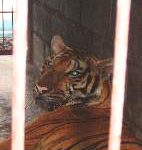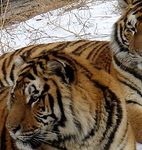One of China’s oldest traditions is its respect for wild nature. Love for nature shines from the early Chinese art, which my grandfather, Sir Alan Barlow, an expert on Chinese pottery, taught me to love. And the tiger, which originated in China, is the emblem of wild nature. Only Chinese art has, from the beginning, painted tigers without reference to people. Not tigers as hunted by men, but tigers alone in the wild. As in the motif of “happy tiger in bamboo.” The tiger enjoying its forest solitude.
From 2000 to 2004, I walked in every type of forest where tigers still live – in India, Bangladesh, Laos, Sumatra, Nepal, Bhutan, Russia and China. In the snowy mountains of Hunchun Tiger Reserve, China, I followed with scientists and conservationists the footprints of dongbei hu, the north-east tiger. I also met local people whose cows are eaten by dongbei hu. These people pray to Shanshen, protector of the mountains, often represented with a tiger companion. I stood with a farmer who pours wine to Shanshen in his backyard altar.
There are many ways of being civilised. People who live in cities need to respect people like this farmer who live close to the wild and who, in their turn, respect the tiger as guardian and protector of wild nature. Their beliefs agree with the most developed modern scientific understanding: that human beings need a healthy environment, that forests are the best guarantee of a country’s physical health, protecting the country’s water, soil and air supplies, and that if the tigers which evolved in those forests still live in them, these are healthy forests, which mean a healthy human environment.
In Shanghai, giving a poetry reading, I learned from my audience about the Chinese writer Lu Xun, who promoted the works of Charles Darwin in the 1920s. I realised that China is one of the very few major powers in the world whose population has total respect for Darwin. Nobody in China questions that evolution is the foundation of biology. Thanks to Darwin, modern biologists know that tigers belong in the forest where they evolved as solitary forest animals. Conserving them properly means conserving wild tigers in their natural environment, the forest.
Conserving tigers in their wild environment helps to conserve human spiritual as well as physical health. “If enjoyment of nature should end, who would understand what all this means?” said Xie Lingyun (385–433), one of China’s first nature poets, in his Mountain Poems. By “all this,” Xie meant human life as well as the world: ourselves-in-our-environment. In philosophy and poetry, as well as in art, Chinese civilisation understood, earlier than anybody, that human beings need wild nature to exist for itself, even if we do never actually enter the wild ourselves: that civilised human life depends on a balance of wild and tame.
Darwin’s great insight was that human beings are connected to other animals: that we are part of nature, not opposed to it. Chinese tradition understood that for our spiritual health, we human beings need the wilderness to exist, even if we never see it or enter it. The balance of wild and domestic keeps us civilised, keeps us human.
Both ancient Chinese tradition and modern scientific thinking, therefore, respect the tiger’s role in protecting wild nature. Today’s scientific understanding of conservation agrees with the deepest human needs, understood by early Chinese tradition, for spiritual and physical human health.
China has many brilliant people who know this, and wish to conserve the tiger according to modern scientific understanding in the environment where it evolved. Unfortunately they face opposition from people who wish to make money out of the tiger, not as a part of wild nature, but as a commodity.
Money can be made from tiger parts because human beings, as they evolved, became supremely symbol-hungry creatures. Tigers are beautiful and powerful symbolic animals, which are now becoming extinct in the wild because human beings have a powerful primitive urge called symbolism – and powerful primitive urges can be translated into money.
It is irrational to hope to become better ourselves – more beautiful and powerful, for instance – by taking part of a tiger’s body into our own. Eating its flesh, or hoping that its bone might cure our sore places. This kind of symbolism is magical thinking, like the wishful thinking of a child.
Chinese herbal medicine is a wonderful tradition and helps people everywhere. But tiger bone is not herbs. Scientifically, without herbal additions, tiger bone has been proven to be exactly the same, and have the same effects, as mole-rat bone. Neither of them has been proved, medically, to help human bodies. But if they did, they would only be a minor analgesic, not even as powerful as aspirin.
It is not the scientific value – the chemistry of this bone – but irrational symbolic belief about what tigers represent, which makes people imagine that tiger parts can cure what is wrong with them. Xiongsen Bear and Mountain Tiger Village in Guilin effectively acknowledges this in a document submitted to the Convention on International Trade in Endangered Species (CITES), saying that selling tiger bone to patients with rheumatism would fulfil a “social need”.
It is mostly poor people who use tiger bone medicine. It would be more responsible to send them to a doctor than legalise the sale of something that is not proven to cure them. To legitimise the use of tiger bone in Chinese medicine, in fact, would blacken the name of Traditional Chinese Medicine throughout the world. To farm tigers in order to provide it, betrays Chinese tradition even more deeply: it betrays China’s tradition of respecting wild nature and valuing spiritual and scientific truth.
First, tiger farming destroys the conservation of wild tigers. Farming wild animals endangers the same animals in the wild: this has been demonstrated everywhere – with bears, crocodiles and turtles, as well as tigers. People make money from it due to human weakness, human greed and human gullibility. People always believe that “wild is better”, and if they can, they pay more for wild than farmed. And so more wild tigers – in other countries, not China – die. Poachers kill wild tigers cheaply everywhere, sell them for Chinese medicine, and make more profit out of them than tiger farmers do out of farmed tigers.
As we can see from the report by the Xiongsen Bear and Mountain Tiger Village, whose 1,300 tigers require five tonnes of meat per day – demonstrating how expensive it is to farm tigers.
Second, no zoo anywhere in the world needs to keep more than five tigers in cages to show to tourists. Breeding tigers like battery hens imitates some of the worst mistakes of western modernisation, which most leading social thinkers in the west now denounce. Keeping so many mole rats in cages – which would be just as effective medically – would be bad enough. But to keep tigers in groups in cages is an offence against evolution and against nature, because tigers evolved to live wild and alone.
Wild and alone is how tigers need to live, as ancient Chinese tradition knew. For our spiritual health, we human beings need to respect this animal to whom Chinese tradition looks up as the solitary “happy tiger in bamboo,” guardian of wild nature.
The money spent on maintaining tigers in Guilin would be far better spent by respecting nature in accordance with Chinese tradition, conserving wild tigers in a wild forest environment, protecting them from poachers and enriching human lives by making a tiger reserve that the international community would respect and marvel at.
Beautiful facilities, and a properly protected reserve to show tigers to tourists properly and scientifically, would not only gain China genuine international respect, but also provide much more money in the long run than the revenue earned from the false magic of legalising the sale of tigers’ bodies.
Tiger farming caters to the most gullible and ignorant aspects of human nature. It is a barbaric practice. It can give China a bad name internationally and thus injure the achievements of China today. To farm tigers in order to sell illegal tiger parts for medicine is a way of earning money that looks primitive and exploitative. The rest of the world has learned from China in the past, from its traditions of respecting nature, science and spiritual truth. Tiger farming betrays these traditions.
Ruth Padel is a leading British poet, a fellow of the Royal Society of Literature and of the Zoological Society of London. She is author of Tigers in Red Weather, an internationally acclaimed book on tiger conservation, and of Darwin – A Life in Poems, the biography in lyric poems of her great-great-grandfather Charles Darwin.
Images: classical Chinese paintings by Zhan Shanzi, from luoshiyy.com



